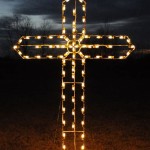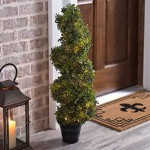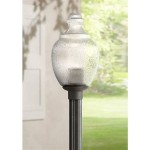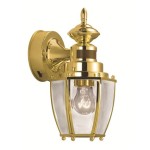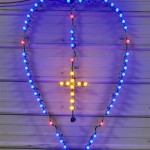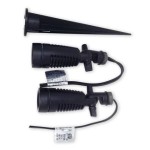Understanding Outdoor Sensor Light Fittings
Outdoor sensor light fittings are a common feature in residential and commercial properties, providing illumination and security. These devices are designed to automatically activate when motion is detected within their sensing range, offering a convenient and energy-efficient lighting solution. The effectiveness and lifespan of an outdoor sensor light depend on several factors, including the quality of the components, the accuracy of the sensor, and the suitability of the fitting for its intended environment.
The core functionality of an outdoor sensor light fitting revolves around its ability to detect movement. This is typically achieved through one of two primary technologies: Passive Infrared (PIR) sensors or microwave sensors. Each type offers distinct advantages and disadvantages, affecting their suitability for various applications and environments.
PIR sensors detect changes in infrared radiation emitted by objects in their field of view. All objects with a temperature above absolute zero emit infrared radiation, and when a warm object, such as a person or vehicle, moves into the sensor's range, the change in infrared radiation triggers the light. Microwave sensors, on the other hand, emit microwave radiation and detect changes in the reflected radiation pattern. Movement within the sensor's range alters the reflected signal, triggering the light. Understanding these differences is crucial for selecting the appropriate sensor technology for a specific location and requirement.
The selection of an appropriate outdoor sensor light fitting involves careful consideration of several factors including the application area, the desired aesthetic, and the environmental conditions. Different types of sensor lights are available, each designed to meet specific needs. Wall-mounted lights are a common choice for illuminating pathways and entrances, while floodlights provide broader coverage for larger areas such as parking lots or backyards. Post-top lights are often used in gardens and driveways, offering both functional lighting and decorative appeal. Choosing the right type ensures optimal performance and integration with the surrounding environment.
Key Considerations for Selecting an Outdoor Sensor Light Fitting
Several key considerations play a crucial role in selecting the most suitable outdoor sensor light fitting. These factors influence the performance, reliability, and longevity of the light, making them essential aspects of the decision-making process. Evaluating these elements ensures that the chosen fitting meets the specific needs of the property and provides optimal security and convenience.
Firstly, the sensor range and detection angle are critical parameters. The sensor range determines how far the sensor can detect movement, while the detection angle defines the width of the area covered. It is important to select a sensor with a range and angle that adequately covers the desired area while minimizing false triggers from movement outside the intended zone. Overly sensitive sensors may trigger unnecessarily, leading to wasted energy and potential annoyance. Conversely, insufficient range or angle may leave areas unmonitored, compromising security. Careful evaluation of the physical space and its specific requirements is essential for determining the appropriate sensor specifications.
Secondly, the light output and color temperature are also important factors. The light output, measured in lumens, determines the brightness of the light. The required light output depends on the size of the area to be illuminated and the desired level of brightness. Color temperature, measured in Kelvin (K), affects the perceived color of the light. Lower color temperatures (e.g., 2700K-3000K) produce a warm, yellowish light, while higher color temperatures (e.g., 4000K-5000K) produce a cooler, whiter light. The choice of color temperature depends on personal preference and the intended use of the light. Warm light is often preferred for creating a welcoming atmosphere, while cooler light is better suited for security purposes as it provides better visibility.
Thirdly, the ingress protection (IP) rating is a crucial consideration, particularly in outdoor applications. The IP rating indicates the level of protection the fitting offers against dust and water ingress. An IP rating consists of two digits: the first digit indicates the level of protection against solid objects, such as dust, and the second digit indicates the level of protection against water. For outdoor applications, an IP rating of at least IP44 is recommended, providing protection against splashing water from any direction. Higher IP ratings, such as IP65 or IP66, offer greater protection against dust and water, making them suitable for more exposed locations. Selecting a fitting with an appropriate IP rating is essential for ensuring its durability and longevity in outdoor environments. Failing to consider the IP rating can lead to premature failure due to water damage or dust accumulation.
Types of Sensor Technology: PIR vs. Microwave
The choice between PIR (Passive Infrared) and microwave sensor technology significantly impacts the performance and suitability of an outdoor sensor light fitting for different applications. Each technology operates on distinct principles and exhibits unique characteristics, influencing their sensitivity, range, and susceptibility to environmental factors. Understanding these differences is essential for selecting the optimal sensor type for a particular environment and security requirement.
PIR sensors offer certain advantages. They are relatively inexpensive and widely available. They are also relatively immune to interference from radio waves and other electromagnetic signals. However, PIR sensors are susceptible to false triggers from various sources, including small animals, moving foliage, and rapid changes in temperature. Their performance can also be affected by obstructions in the sensor's field of view, such as trees or walls. PIR sensors typically have a limited detection range, which may be a disadvantage in larger areas.
Microwave sensors, in contrast, offer a wider detection range and are less susceptible to false triggers from small animals and foliage. They can also detect movement through walls and other non-metallic objects, providing a wider and more comprehensive coverage area. However, microwave sensors are more expensive than PIR sensors and may be susceptible to interference from other microwave devices, such as radar systems or microwave ovens. They also consume more power than PIR sensors, which may be a concern in applications where energy efficiency is a priority.
The choice between PIR and microwave sensors ultimately depends on the specific requirements of the application. For smaller areas where cost is a primary concern, PIR sensors may be a suitable option. However, for larger areas or environments where false triggers are a concern, microwave sensors may provide better performance and reliability. A thorough assessment of the environment and the desired level of security is crucial for making an informed decision.
Installation and Maintenance of Outdoor Sensor Light Fittings
Proper installation and regular maintenance are essential for ensuring the optimal performance and longevity of outdoor sensor light fittings. Incorrect installation can lead to malfunctions, reduced sensitivity, and even safety hazards. Regular maintenance, on the other hand, helps to prevent problems and ensures that the fitting continues to operate effectively over time. Adhering to recommended installation guidelines and implementing a consistent maintenance schedule are crucial for maximizing the lifespan and effectiveness of these devices.
Installation should always be carried out following the manufacturer's instructions and in accordance with local electrical codes. It is crucial to ensure that the power supply is properly disconnected before commencing any installation work. The fitting should be securely mounted on a stable surface, and all wiring connections should be properly insulated and protected from the elements. The sensor should be positioned to avoid obstructions that could interfere with its detection range. The height and angle of the sensor should be adjusted to ensure optimal coverage of the desired area. Incorrect installation can compromise the sensor's performance and potentially create a safety hazard.
Maintenance should include regular cleaning of the sensor lens to remove dirt and debris that could obstruct its view. The lens can be cleaned with a soft cloth and mild detergent. It is also important to periodically check the wiring connections to ensure that they are secure and free from corrosion. Any damaged or worn wiring should be replaced immediately. The light bulb or LED should also be checked regularly and replaced as needed. For LED fittings, it is important to choose a replacement LED with the correct voltage and wattage. Regular maintenance helps to prevent problems and ensures that the fitting continues to operate effectively over time.
In addition to regular cleaning and inspection, it is also important to address any issues that may arise promptly. If the sensor light is not functioning correctly, troubleshoot the problem by checking the power supply, the wiring connections, and the sensor settings. If the problem persists, consult a qualified electrician. Attempting to repair the fitting without proper knowledge and expertise can be dangerous and may void the warranty.
/product/19/227124/1.jpg?strip=all)
915 Generation 12w Motion Sensor Light Outdoor Indoor Movement Best Jumia Egypt

Outdoor Motion Sensor Lights Lamps Plus

Dusk To Dawn Motion Sensor Outdoor Porch Lights With Gfci Waterproof Light Fixture Anti Rust Exterior Wall Mount 3 Modes For House Garage Bulb Not Included Com

Discover The Benefits Of Outdoor Motion Sensor Lights Staysafe Org

Outdoor Pir Motion Sensor Lights Universal Lighting
Wanaka 2 Light Up Down Exterior Wall With Sensor In Black Beacon Lighting

Stan 15 1 2 High Gray Wood Dual Bright Motion Sensor Outdoor Light 71p59 Lamps Plus

Westinghouse Two Light 18w Led Outdoor Security Wall Fixture With Motion Sensor Broe Finish

Auraglow Pir Motion Sensor Up Down Outdoor Wall Security Light Warminster Stainless Steel Led Lighting

Sensor Night Wall Light Battery Powered Motion Lights Wireless 9 Leds Spotlight Indoor And Outdoor Garden Security Led Lamp Auto On Off Porch For
Related Posts
